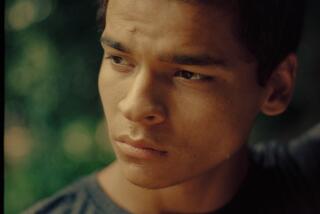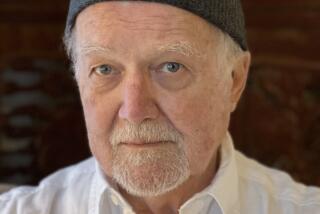Love, madness, mystery
- Share via
AS John Fowles did in “The French Lieutenant’s Woman,” Russell Banks arrests his reader’s attention in “The Reserve” straight off with the image of a mysterious young woman staring out at open water, though it’s not Fowles’ briny Atlantic but the considerably smaller expanse of an Adirondacks lake -- which is nonetheless large enough for Jordan Groves to land his pontoon airplane. Jordan is an artist and adventurer whose subsequent meeting with a beautiful heiress puts flame to the fuse that sizzles through several hundred pages on its way to a high-combustion mix of eros and thanatos.
Set mainly in 1930s America (there are a few short sections in European locales), the novel plays out themes of erotic obsession, madness and duty -- and weaves in specific elements (and figures) of the times: politics, the Spanish Civil War, the Hindenburg’s transatlantic flights, the emerging practice of psychoanalysis.
Banks has written a short note about the novel in which he reflects on its origins as well as the fascinating convergence of his sources and influences. Aside from wishing to work on a narrative that would bring him closer to the era of his parents’ youth and the attractions of the Adirondacks as a locale (so near his own home of 20 years), he confides his abiding fascination with the life and work of illustrator Rockwell Kent, whose career merged artistic aspiration with intense leftist political convictions. Further, Banks has read an unedited manuscript of Ernest Hemingway’s “To Have and Have Not” and concluded that the female character was based on a real-life mistress of Hemingway’s, who by all accounts was “mind-numbingly beautiful” but also emotionally unstable. (She apparently also was the model for the vengeful wife in Hemingway’s “The Short Happy Life of Francis Macomber.”)
All these elements and others, Banks admits, combined in his imagination (in ways that can, of course, never be accounted) to produce this riveting narrative, featuring an almost pot-boiling love story set against a backdrop of global unrest and clearly demarcated class tensions.
The story opens with Jordan’s arrival on the Fourth of July at the privileged rural enclave known as “The Reserve,” to look at Dr. Carter Cole’s collection of the paintings of his colleague James Heldon. Jordan leaves a few hours later with Cole’s adopted daughter, Vanessa, beside him in the plane. They are sneaking away to watch a local fireworks display, though it would not be a stretch to say, in the pointed and innuendo-laced style of that period (at least as we have it from the films of Howard Hawks and others), that they are the fireworks. After the inevitable parrying, after Vanessa has had her turn at the controls, they land in a secluded spot for the viewing.
The scene is set. But no: “He watched her walk out of moonlight into darkness, and he knew what would happen if he followed. He started the engine, and the airplane drifted down shore a ways, where he brought it around to face the wind and open water.”
Jordan leaves -- it’s part of their sparring -- but no reader will imagine for an instant that he has done anything but dig himself in deeper with the twice-married heiress. Who would doubt it: Desire plus obstacle leads inevitably to drama and the mounting sense of inevitability that is the dramatist’s stock in trade. Jordan is married with children. Vanessa carries the stigma -- and appeal -- of a reckless marital past.
When her wealthy father dies suddenly, Vanessa’s mother takes radical steps to block her inheritance, including trying to have her committed to psychiatric care in Europe. Then there is the handsome but taciturn Hubert, one of the locals who help with the care-taking of the well-to-do. He is, it seems, having an affair with Jordan’s wife, the discovery of which sets into motion the contrapuntal romantic action of the novel. Hubert’s presence, along with that of the other locals, puts the doings of the elite into sharp relief.
That relief could be said to be the only kind on offer, for the unfolding plot -- not to be summed up -- is relentless with complication. This is at once the source of its compulsive momentum and -- from a certain angle, that of the high-minded critic angle -- its liability. Banks is one of our most estimable novelists, and in such novels as “Continental Drift,” “Affliction,” “The Sweet Hereafter” and “Cloudsplitter,” he has animated charged scenarios with distinct moral urgency. That urgency has stamped them “serious literature,” while his gift for scenic intensity has allowed them to be turned into well-received -- and serious -- films.
“The Reserve” has character and scene -- as well as suspense and surprise -- in abundance. An artist adventurer and a beautiful if unstable heiress, a picturesque setting, more than a dash of political engagement (we see Jordan flying bombing missions in Spain, writing to his friend John Dos Passos), intrigue and cataclysm; it’s all ready, for the shooting script. Perhaps too ready.
Again and again, there is a sense that the scene construction was led along by the dictates of cinema. The episodes are packed tightly together, expertly staged for visual transposition -- but to the extent that there is no room for resonances to build. The political and social premises are tantalizing, but the twists and turns of the complicated relationships -- especially the emerging depths of the psychology of Vanessa’s feelings about her father, for instance -- never let them become realized.
Banks works with a vast palette and a sure stylistic command. “The Reserve” gratifies page by page. But when the pages are gathered together, held in retrospect, there is the sense of an echo still awaited, some deeper gratification promised in the meditative pose of the mysterious, beautiful woman on the first page.
--
(BEGIN TEXT OF INFOBOX)
From ‘The Reserve’
By Russell Banks
The pilot scouted along the shore below the camp for a shallow beach and found it close by the young woman standing away from the others. She seemed lost in thought, in a blue mood, and did not look at him, but did not seem to be avoiding him, either. She was like an exhibit, a piece of sculpture set at the edge of the lake -- part of the view. She was very pretty, he noticed when he drew near shore. Beautiful, even. She had high, almost Andean cheekbones and sharp, precise features, bright blue eyes, and full lips. She wore no makeup, or none that he could discern, and her long, gingery hair hung loosely over her shoulders. Broad shoulders for a slender woman, he noticed. She must be an athlete, a swimmer or a serious canoeist. Maybe she’s an actress, he thought. She looks like an actress. Her face was vaguely familiar to him, and then he remembered who she was.
More to Read
Sign up for our Book Club newsletter
Get the latest news, events and more from the Los Angeles Times Book Club, and help us get L.A. reading and talking.
You may occasionally receive promotional content from the Los Angeles Times.







